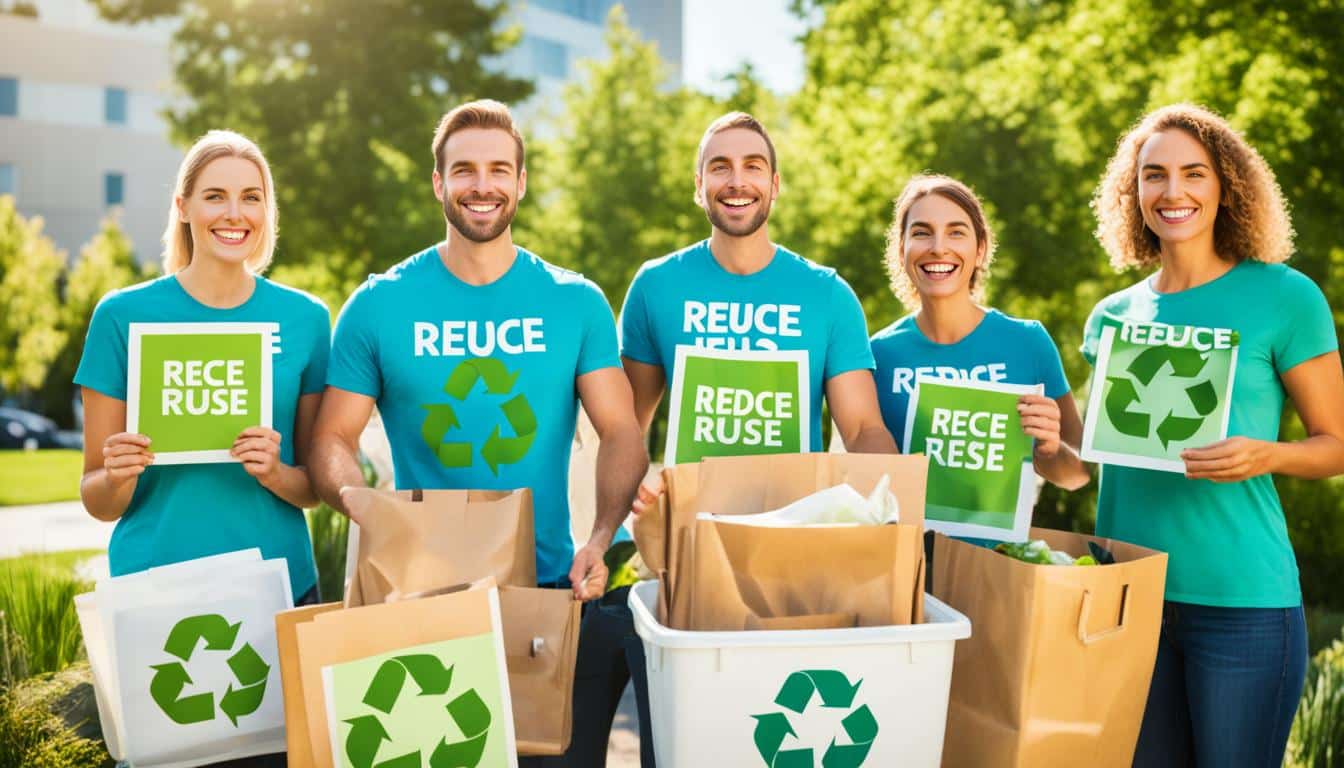Menu

Did you know that 74% of Millennials and Gen Z are ready to pay more for sustainable products? This shows the big role of sustainability in today’s marketing. In the digital age, showing a strong commitment to green practices on social media is key for brands. It helps connect with the younger, eco-conscious crowd. To reach Gen Z, known for their environmental concerns, a clear and interesting online story of responsible business is a must.
Brands compete in being seen as green. They should use social media to share their green efforts. This not only makes their market position better but also builds a loyal fan base. This drives towards a planet-friendly way of buying for everyone.
Showcasing environmental efforts on social media helps brands connect with eco-conscious customers. This connection is vital in winning their trust. This is especially true for Gen Z, who make up 40% of the world’s buyers.
Showing off green practices on social media deepens links with green-minded buyers. Telling real stories about green work, like using electric cars or making sustainable clothes, makes a brand more human. It builds trust and loyalty. Studies reveal 60% of shoppers choose or avoid brands based on what they do for the planet.
To connect with green consumers online, brands must smartly show their efforts. For example, the food sector could highlight organic farm and travel could promote green tips. Social media educates about a brand’s green work. This could lead to more spending, since one third to two-thirds of buyers are ready to spend more on environment-friendly brands.
| Industry | Key Sustainability Focus | Effective Social Media Strategy |
|---|---|---|
| Fashion | Sustainable collections and eco-friendly processes | Visual storytelling and influencer partnerships |
| Food & Beverage | Organic ingredients and recyclable packaging | Highlighting sustainable farming practices |
| Automotive | Electric vehicles and sustainable materials | Authentic storytelling and visual content |
| Travel & Tourism | Eco-friendly destinations and responsible travel tips | Sharing images and promoting eco-friendly tips |
| Retail | Eco-friendly products and sustainable packaging | Highlighting sustainable product collections |
| Technology | Energy-efficient products and sustainable manufacturing | Tracking engagement rates and sales metrics |
Using social media to market sustainability is powerful. It allows brands to interact with conscious consumers. By doing so earnestly, they can develop strong relationships that sway purchasing choices. This, in turn, moves the market towards a more sustainable future.
In today’s world, being real and open is key. It helps brands build trust and credibility with people who care about the planet. Companies that share authentic sustainability content and keep transparent sustainable practices earn respect from mindful audiences.

Being truthful in what we share is crucial for acting ethically and connecting well today. It’s about telling customers the full truth about how companies run, their rules, and finances. Patagonia is a great example. They have become a trusted brand because they are clear in how they talk and work, which sets a good example for others. This kind of openness even helps companies do better with Gen Z and Millennials, who really care about honesty in marketing.
Greenwashing can really hurt a company’s image. To steer clear of this problem, businesses must honestly show what they do to help the planet. Fenty Beauty saw more sales by being clear that everyone is welcome. This shows being honest about green efforts connects well with people. It leads to real talks, good reviews, and keeps customers happy, which beats greenwashing mistakes.
Visual content stands out greatly on social media, especially on Instagram. This fact opens a big door for brands to tell stories of their green efforts through visuals. They can use videos and photos to show off their eco-friendly side. This helps spread the word on being green and motivates people.
Videos and photos can really boost how people interact with a brand’s green message. A study from 2021 found that 54% of marketers find videos very useful for their social media plans. Brands should aim for content that’s both interesting and true to their green goals. This way, they can grab people’s attention. For example, tweets with images are three times more engaging, and Instagram posts with several images see a good interaction rate.
The power of visual storytelling lies in its ability to convey complex sustainability messages quickly and effectively. Engaging videos and high-quality images can vividly portray eco-friendly initiatives, making them relatable and inspiring action among viewers.
Live shows of green practices give a real look at a brand’s environment care. Real-time posts, like live videos on Facebook or Instagram, show off their green efforts live. This not only builds trust but also teaches people about easy ways to be sustainable. By doing live shows, brands deeply connect with green-minded people.
| Platform | Content Type | Engagement Rate |
|---|---|---|
| Carousel Posts | 3.15% | |
| Tweets with Visuals | 3x Higher Engagement | |
| Posts with Images | 98% Higher Comment Rate |
Using visuals in green social media plans can really boost a brand’s image and help make good changes. It could be through videos, photos, or live demos. Visuals stay key in sending out green messages on social media.
Working with influencers in sustainability offers great chances for eco-conscious brands. These sustainable social media collaborations boost your message. They reach people keen to help the planet.

Choosing the right eco-friendly influencer campaigns means finding those who share your values. Influencers such as Aditi Mayer and Bea Johnson lead in sustainable living. Aditi focuses on eco fashion, and Bea is the zero waste home guru. They connect well with green-minded audiences.
Immy Lucas and Rob Greenfield add their perspectives, focusing on veganism and simple living. It’s essential they truly care about eco issues. This builds trust in your eco campaigns.
Pairing with influencers has many pluses. Their strong follower base helps spread your message further. Influencers like Kathryn Kellogg and Isaias Hernandez are well-trusted voices in sustainable living. They can boost your eco products or practices.
| Influencer | Focus Area | Notable Collaborations |
|---|---|---|
| Aditi Mayer | Sustainable Fashion | – |
| Bea Johnson | Zero-Waste Living | – |
| Rob Greenfield | Sustainable Lifestyle | VIVOBAREFOOT |
| Jessica Clifton | Eco-Friendly Products | Grove Collaborative |
| Andrew Burgess | DIY Projects, Upcycling | Puma |
Sustainable social media collaborations with influencers help keep your message real. They make it easier to talk to green-hearted people. These collaborations tell better stories. This makes your eco efforts more relatable and doable for shoppers.
Interactive content is key to getting people involved in talk about sustainability. It turns them from watchers to doers. With things like polls, quizzes, and content made by users, brands get people a lot more involved. This makes for a lively community focused on sustainability.
Polls and quizzes are great at getting audiences interested in being green. They do this by learning what people think and teaching them about new green habits. For instance, a quiz on the best ways to recycle is fun and helps people get closer to the brand.
Getting fans to share their green actions is a big win too. It helps create a story powered by the community, which eco-minded people find really appealing. This kind of content is true and makes the brand’s green message more genuine.
Then, there are online challenges. For example, a challenge to go plastic-free for a week gets people to share their progress. This builds a close-knit group and adds a lot of green content, making the brand look even better and more trustworthy.
| Strategy | Benefit |
|---|---|
| Polls | Collect valuable audience insights and encourage interaction. |
| Quizzes | Educate and inform audiences on sustainability topics. |
| User-Generated Content | Amplify authentic narratives and foster community. |
| Virtual Challenges | Engage participants in sustainability efforts and generate content. |
By adding interactive green content, like polls, quizzes, and user-made content, brands can connect more deeply with their audience. This not only boosts green engagement but also inspires positive change.
Brands need to match their social media messages with each platform’s unique features. By using several platforms, businesses can talk about sustainability in different ways. This helps them connect with more people and get them interested.

Instagram is perfect for sharing stories with pictures and videos. It’s great for showing off eco-friendly practices and products. After seeing these posts, 75% of people started using less plastic. Almost 70% found new ways to reduce waste.
Twitter is all about quick updates and joining conversations as they happen. Brands can talk about the latest on sustainability and answer questions fast. For example, because of Hellmann’s tweets, 82% started working on food waste.
LinkedIn is key for connecting with people in the same industry about sustainability. It’s a good place for sharing in-depth information and joining forces for sustainable change. Platforms like LinkedIn help to spread the word and make important business links.
Each platform plays a different part in telling the story of sustainability on social media. Using a mix helps businesses talk to more people in meaningful ways. This can lead to real progress for the environment.
In the current digital age, it’s key to show corporate social responsibility online. With over 4.9 billion active users on social media, a strong CSR digital strategy is a must. It helps build trust and reaches a wide audience. The stats reveal that 60% of people worldwide would stop buying from a brand that doesn’t support important causes.
Companies that talk about their CSR work often see good returns. For example, 87% of people are more likely to visit a brand’s site if they follow it online. This highlights the importance of making CSR part of your online strategy. Brands like Adidas, with their work for the oceans, show that listening and acting on social input can really help their image.
Gen Z, making up 40% of shoppers globally, looks for brands that care. They want to buy from companies that are green and do good. Using social media to talk about your CSR work helps draw them in. It also makes your brand look good to others too.
To be truly effective online with CSR, be real. A study finds that 83% of people trust companies more when they show their CSR work online. Using social media the right way can win trust. But be careful not to pretend to be more eco-friendly than you are. People can spot fake claims, which leads to losing trust.
Using a mix of social media to spread your CSR message far works well. Instagram can show off green projects beautifully. Twitter updates can keep people in the loop about your efforts. LinkedIn can help with networking and sharing detailed CSR reports with those interested.
Here’s an insightful look at the impact of highlighting CSR online:
| Statistic | Impact |
|---|---|
| 78% | Customers believe socially responsible companies are more trustworthy. |
| 63% | Consumers prefer companies committed to sustainability. |
| 45% | Employees are more likely to stay with CSR-focused companies. |
| 60% | Companies report an increase in positive brand perception after CSR initiatives. |
| 87% | Consumers are willing to purchase products supporting causes they care about. |
In the end, making corporate social responsibility part of your online brand is smart business. It’s not just about ethics; it can lead to more loyal customers and success for your company overall.
It’s key to keep a clear, consistent sustainability message. This helps build trust in your brand and keeps consumers engaged. Make sure your messages mix eco-friendly stories with promotional stuff. This way, people don’t see your efforts as just a way to sell more.

To get a strong consistent sustainability message, keep things the same on all platforms. About 60% of marketing pros look at social media to see if they’re doing well. So, make sure the ‘green’ message looks and sounds the same, whether it’s on Instagram, Twitter, or LinkedIn.
Finding a good marketing sustainability mix stops people from tuning out. Most folks like it when brands reply quickly. So, mix sustainability news with your regular ads. This shows you’re serious about helping the planet without just trying to sell more.
Alongside this, a study by The 2023 Sprout Social Index™ shows that 81% of marketers say AI helps a lot. Tools like these make it easier to balance your message everywhere. They help keep your cross-platform green message fresh and in line with what people want and say.
| Aspect | Importance | Statistics |
|---|---|---|
| Consistency | High | 60% of marketers track social media traffic to maintain consistency |
| Balancing Content | Crucial | 76% of consumers value quick brand responses |
| Automation | Beneficial | 81% of marketers agree AI positively impacts their work |
Looking at how top brands achieve sustainability teaches us a lot. These companies don’t just work towards being green. They also dream of a world that’s much greener.
Patagonia has set a high bar in the green business world. Since 1985, they’ve given part of their profits to environmental causes. This shows their strong support for the planet. The brand is careful about what it uses to make clothes, choosing eco-friendly and recycled stuff. It also says ‘use it again’ rather than ‘throw it away.’ Doing this helps save the planet.
They also talk about big issues facing our earth. So, Patagonia isn’t just a brand; it’s a leader in saving our environment.
IKEA wants to be good for the climate by 2030. This is under their IWAY code, which is all about doing business in a way that’s good for everyone. It’s been this way for more than 20 years. IKEA is serious about using less energy and producing fewer harmful gases.
They keep coming up with new ways to be kinder to the planet, like using materials that make less pollution. This is how they, as a big company, are helping a lot towards a green future.
| Brand | Initiative | Impact |
|---|---|---|
| Patagonia | Dedication of a portion of sales to environmental causes and use of recycled materials | Significant reduction in environmental footprint and raised awareness |
| IKEA | IWAY supplier code, climate positive strategy | Long-term reduction in carbon footprint, aim to be climate positive by 2030 |
It’s vital to understand how your sustainability campaigns make a difference. This helps you know if they work well and what to do next. Today, putting efforts into sustainability is key for good marketing.
There are several important ways to measure the impact of your efforts:
Measuring success in terms of campaigns, you need numbers and stories. This includes things like views online and sales, but also how people’s habits or thoughts are changing.
Using various tools is key to understanding your impact well.
Using these different tools provides a full picture of the change you’re making. It helps you keep getting better at being green.

| Aspect | Traditional Metrics | Sustainability Metrics |
|---|---|---|
| Content Reach | Viewership Numbers | Web Traffic, Organic Reach |
| Engagement | Likes, Shares | Social Media Engagement, Feedback |
| Economic Impact | Sales Numbers | Sales of Sustainable Products, ROI |
| Behavioural Change | Short-term Reactions | Consumer Behaviour Shifts, Awareness Levels |
Using these metrics with the right tools helps you see how well your green efforts are working. It encourages improvement, keeping your brand leading in sustainability.
It’s crucial to adapt sustainability plans according to what your audience says. This keeps your efforts relevant and engaging. By using a feedback loop system, businesses can change their strategies based on customer opinions and market trends.
Customer feedback is key to making products and services better in a competitive market. A feedback loop includes Collection, Analysis, Action, and Follow-up steps. You can gather insights through surveys, interviews, social media, and feedback tools. Giving rewards boosts the number of responses you get.
Numbers from quantitative analysis give solid insights, while qualitative analysis looks at feelings and ideas. Tools like NVivo and Atlas.ti help with this. Putting feedback into CRM systems helps to keep track of customer happiness and spot trends.
Changing to be greener is important for appealing to people who care about the environment. By looking at feedback in different ways, like by age or interest, you can fine-tune your approach. Social media makes it easy to get feedback fast and make quick changes.
Companies using smart marketing have seen good results from adapting their sustainability efforts. Monitoring customer behaviour, sales, and website visits helps in predicting future market trends. Always learning and growing as a marketing team keeps your strategies fresh. Feedback and insights from the audience are invaluable for tweaking marketing plans to meet their changing needs.
| Stages of Feedback Loop | Methods for Collection | Analysis Tools | Segmentation |
|---|---|---|---|
| Collection | Surveys, Social Media | NVivo, Atlas.ti | Demographic |
| Analysis | Interviews, In-App Tools | Trend Analysis | Behavioural |
| Action | Incentives | Sentiment Analysis | Product/Service |
| Follow-up | CRM Systems | Correlation Analysis |
In today’s market, appealing to eco-conscious consumers is key. Studies show half of consumers think about sustainability when they buy. So, it’s important for brands to merge digital marketing with sustainability. This helps them stay vital and ahead.

Using green marketing on social media brings big wins. It helps brands stand out, grow a solid fan base, and better their reputation. Visual posts do well online. They grab attention and stir action, showing how powerful eco-strategies are.
Listening and watching social media are goldmines for understanding what consumers think. They give a peek into what people want from green products, what competitors are doing, and industry trends. This info is vital for shaping a brand’s digital marketing sustainability plan. It helps meet consumer expectations. For instance, sticking to green rules like California’s Title 24 boosts a brand’s green image. It makes consumers trust them more.
Checking the impact of these green strategies is crucial. Analyzing social media numbers is the way to go. This knowledge helps brands make better social media decisions. It leads to better online eco-presence, moving with the latest trends.
Education is key in promoting a sustainable future. The Brundtland Commission in 1987 said sustainable development ‘meets the needs of today without hurting the future’s ability to do the same.’ To reach this goal, we need to inform others and make the public understand.
Brands play a big role in spreading the word about sustainability. The UNESCO International Implementation Scheme for the DESD says sustainability is about valuing other people, differences, and the planet. By sharing posts about these values, we can increase awareness and inspire action. The UNESCO DESD highlights related initiatives.
Good sustainability marketing means working with schools to share important messages. The UN Summit in Johannesburg back in 2002 stressed the need to change our education systems for sustainable living. Working with schools helps bring what’s taught to the real world. ECO-UNESCO’s 2007 effort showed this approach boosts people’s interest, offering many chances for working together.
These partnerships help make green efforts more visible. They also build a community that’s both aware and keen to be more sustainable.
| Aspect | Description |
|---|---|
| Raising Awareness | Leveraging platforms to share informative environmental content and principles. |
| Educational Partnerships | Collaborating with educational bodies to enhance practical applications of sustainability. |
| Values and Principles | Spreading awareness about respect for others, diversity, and environmental stewardship. |
| Community Engagement | Fostering a well-informed community ready to adopt sustainable practices. |
In today’s digital age, building sustainable communities is key. Kickstarter leaders say being real is essential for vibrant green communities. Brands need to make products creators truly care about to connect with their audience on eco initiatives.
Sharing what you do and listening to feedback is vital. Both online and offline, testing responses helps find supporters. Remember, a few deeply passionate supporters matter more than a lot who are not as involved.
Backing artists and their financial potential is key. More support often comes from within a community than expected. Valuing these supporters really helps eco projects grow.
Being clear about what you offer, and at what cost, is important. Businesses need to lead by example, being open and inclusive. Diversity and inclusion work to build a strong green values community.

Success in a community means focusing on quality and community fit. Social marketing with ethical practices boosts sustainable product demand.
Using social media well can boost community building. Today, people look for realness and truth. Sustainable brands show their values, gaining trust and standing out from others.
At its core, shared green values within a community help the planet. This effort encourages more people and businesses to go green.
| Aspect | Importance |
|---|---|
| Authenticity | Crucial for genuine engagement and building trust |
| Core Stakeholders | More beneficial than amassing a large, less committed following |
| Recognition of Supporters | Builds a strong, supportive community |
| Clear Communication | Sets realistic expectations and facilitates trust |
| Inclusivity and Diversity | Foundational for community-building |
| Social Media Engagement | Extends reach and fosters brand loyalty |
As we near the end of this discussion, we see how vital it is to blend sustainability into our online activities. This isn’t just about doing the right thing. It’s key for staying relevant. Both Millennials and Gen Z are big on green causes. So, brands must use social media to meet the high demand for ‘green’ products.
Today, going green isn’t optional for businesses. It’s demanded by earth-loving customers. Yet, the risk of pretending to be green without real actions is real. Companies can fight this by being super open. They should also follow local green rules closely and often check on how they’re getting their green message across. This way, they won’t mislead their followers.
The food sector has a huge role in harming our planet. Around a third of all household harm to the environment is from producing and eating food. Social platforms are helping change our eating habits. They make it easy for us to find advice on eco-friendly living. Unlike regular media, people trust online groups for helpful and less overwhelming info.
By using social media well, companies can tell their green stories. They can connect with people who care about the environment. This helps build a strong community of like-minded green-loving folks. Being honest, open to change, and listening to what customers say is the way forward. It’s how we can move the business world towards a greener tomorrow.
To show your commitment to the environment on social media, make regular posts. These should talk about your green projects, achievements, and aims. Share posts that teach, post beautiful images, and tell stories. This will help people see how your work helps the world around us.
Showing how you care for our planet makes people trust and love your brand more, especially the younger Generation Z. They prefer buying from honest and green companies. It also lets them know they’re supporting the right causes.
Be real when you talk about your eco-friendly efforts. Tell people what’s really happening. Stay away from big claims that aren’t true. Share both your successes and your challenges. This way, people will trust you more.
Use powerful photos and videos to show what you’re doing to help the planet. Live videos and rare insights into your work bring a real, honest feel to your message. This makes caring for the Earth more real and interesting to your viewers.
Working with influencers who really support green causes can make your message stronger. They help get your message to new people. Their followers trust them, so they might end up trusting you too.
Use fun things like polls and challenges to get people talking about saving the Earth. Ask them to share their own ways of helping. This not only gets more people involved but also creates a real community spirit.
Every social media platform is unique. For example, Instagram is great for telling visual stories. Twitter is perfect for sharing quick updates. LinkedIn helps you connect with professionals interested in your work. Use each one’s strengths to get your message across better.
It’s very important to show what you’re doing for the planet online. This includes your efforts and your successes. It builds trust with everyone. And it encourages more people to join in on making the world a better place.
Keep your message about saving the Earth the same on all platforms. This helps build trust with your followers. Remember, it’s important that they see you are honestly dedicated to this cause.
Look at Patagonia and IKEA for great examples. Since 1985, Patagonia has been a leader in green movements. IKEA is aiming to do even better, aiming for a climate-positive future by 2030. These brands are known for their green efforts, which are a big part of their message and work.
Keep an eye on your website traffic, how much people engage with your social media, and your sales. This will show if your green campaigns are making a difference. Use tools that help you analyse the data to do better and grow.
Listening and changing based on what your audience says is key. It keeps your campaigns up to date and working well. Understand what your audience wants, and adjust your message. This way, everyone stays interested and involved.
To build strong social media strategies, tell your story in a special way and match your message to each platform. Focus on engaging posts, teaming up with influencers, and always being clear with what you say.
Teaching people about protecting our planet is really important. You can share posts that inform and work with schools to teach people directly. This makes your work more understood and valued.
Creating a community with a focus on green living will support and spread your message. It creates a strong group of supporters who will talk about your efforts. This not only keeps people loyal to your brand but also makes a bigger impact.